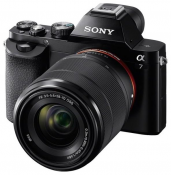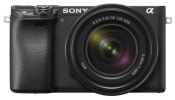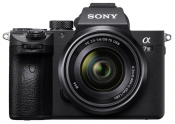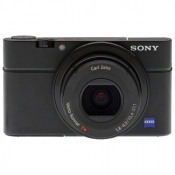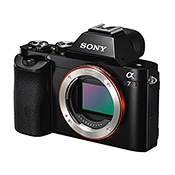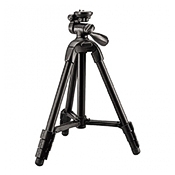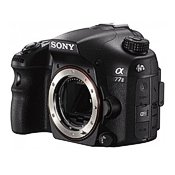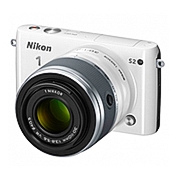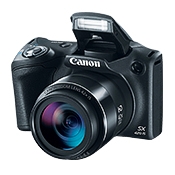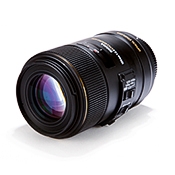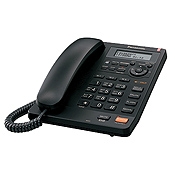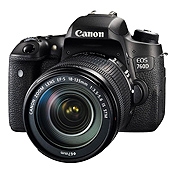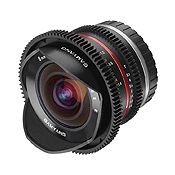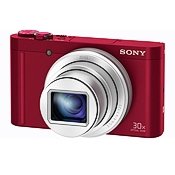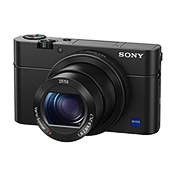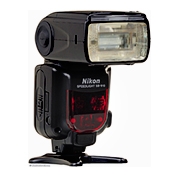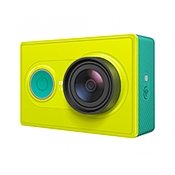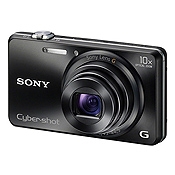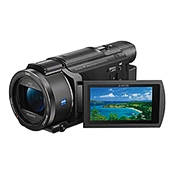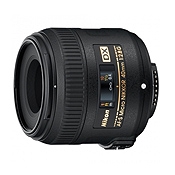Sony Alpha ILCE-6000 Kit
Short review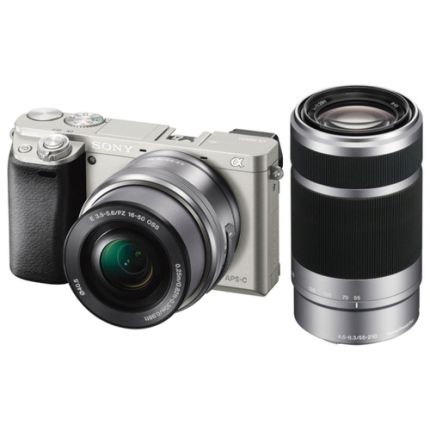
Buy Sony Alpha ILCE-6000 Kit
Sony Alpha ILCE-6000 Kit Specifications
Yandex.Market data
| Camera | |
| Camera type | mirrorless with interchangeable optics |
| Lens | |
| Interchangeable lens support | mount Sony E |
| Lens included | there is |
| Matrix | |
| Total Pixels | 24.7 M |
| Effective Pixels | 24.3 M |
| The size | APS-C (23.5 x 15.6 mm) |
| Crop factor | 1.5 |
| Maximum resolution | 6000 x 4000 |
| Matrix type | CMOS |
| Sensitivity | 100 - 3200 ISO, Auto ISO |
| Extended ISO values | ISO100, ISO6400, ISO12800, ISO25600, ISO51200 |
| Matrix cleaning function | there is |
| Functionality | |
| Shooting 3D | there is |
| White balance | automatic, manual, from the list, bracketing |
| Flash | built-in, up to 6 m, red-eye reduction, shoe, bracketing |
| Image Stabilizer (Still Image) | is absent |
| Shooting modes | |
| Shooting speed | 11 fps |
| Timer | there is |
| Timer running time | 2, 10 s |
| Aspect ratio (still image) | 3:2, 16:9 |
| Viewfinder and LCD | |
| Viewfinder | electronic |
| Using the screen as a viewfinder | there is |
| Viewfinder field of view | 100% |
| Viewfinder Pixels | 1440000 |
| LCD screen | 921,600 dots, 3 inches |
| LCD screen type | turning |
| Exposition | |
| X-Sync shutter speed | 1/100 s |
| Manual setting of shutter speed and aperture | there is |
| Automatic exposure processing | shutter priority, aperture priority |
| Exposure compensation | +/- 5 EV in 1/3-stop increments |
| Exposure metering | multizone, center-weighted, point |
| Exposure Bracketing | there is |
| Focusing | |
| Autofocus type | hybrid |
| AF illuminator | there is |
| Manual focus | there is |
| Face Focus | there is |
| Memory and interfaces | |
| Memory card type | SD, SDHC, SDXC, Memory Stick, Memory Stick Duo, Memory Stick Pro Duo, Memory Stick PRO-HG Duo |
| Image formats | JPEG (2 levels compressed), RAW |
| RAW + JPEG recording mode | there is |
| Interfaces | USB 2.0, HD video, HDMI, Wi-Fi, remote control connector |
| Food | |
| Battery format | your own |
| Number of batteries | 1 |
| Battery capacity | 1080 mAh or 360 photos |
| Video and sound recording | |
| Video recording | there is |
| Video recording format | AVCHD, MP4 |
| Video codecs | AVC / H.264, MPEG4 |
| Maximum video resolution | 1920x1080 |
| Maximum video frame rate | 60 frames / s |
| Maximum frame rate when shooting HD video | 50/60 fps @ 1920x1080 |
| Sound recording | there is |
| Other functions and features | |
| Digital Zoom | 4x |
| Additional features | tripod mount, remote control, computer control, HDR shooting |
| Sales start date | 2014-04-15 |
| Dimensions and weight | |
| The size | 120x67x45 mm, without lens |
| Weight | 285 g, without batteries; 460 g, with batteries, without lens |
Opinions from the Sony Alpha ILCE-6000 Kit
Yandex.Market data
Advantages:
The impression from shooting on the A6000 with a "pro" lens (for example, with a manual Samyang 16mm f / 2.0 ED AS UMC CS) is very good. Raw camera full-size Jpeg in quality looks like after processing RAW in Lightroom: clarity, "airiness" and "transparency" of the frame; Glass and people's eyes look "more alive than living".
Disadvantages:
But all this is only with "real" optics. And with her - huge problems! For a high-quality photo on the A6000, the lens must have a resolution not lower than the matrix resolution (24 MP). But none of the commercially available E-lenses has such parameters, and just a few of them are of high quality (with a resolution above 12MP) - only a few (see the data of the DxoMARK portal). http://album.foto.ru/photos/pr2/214068/3940719.jpg The 16-50mm whale lens has low quality (5… 6MP according to DxoMARK tests) and does not resolve the 24MP matrix. More - less than normal photos from him only in bright sun outside. And indoors it gives a terrible soap on an open diaphragm, and on a closed one only a little better: all photos must be resized to 75-50% at once, sharpened, adjusted levels (otherwise the photos will be at the level of a soap dish and worse), and for “street The photo from the whale is practically the same situation.
Comment:
For a high-quality photo with the A6000, the kit must be changed immediately. But most of the released E-lenses (and other systems too) are "sharpened" specifically for portrait / art photography: these are high-aperture normal and telephoto lenses, for example Sony 35mm / 1.8 to 50mm / 1.8. Therefore, you can choose a lens for a high-quality portrait with a blurred background. But there are no high-quality fast wide-angles! Shorter than 25mm and lighter than 2.8, only a Sony "pancake" 20mm / 2.8 (with soap it is no better than a whale (resolution 7 ... 8MP according to DxoMARK tests), Sigma 19mm / 2.8 (the same level), and the notorious Carl Zeiss Sonnar T * 24mm f / 1.8 at a price 1.5 times more than the A6000 with a whale.http: //album.foto.ru/photos/pr2/214068/3940719.jpg From DxoMark tests it is clear that only three E-lenses out of all. With the rest there will be pictures like 6 ... 9 MP soap cameras and the full potential of the A6000 carcass will remain unrealized. The rest are either dark, or in terms of resolution and contrast at the level of a whale (like most E-lenses with variable focal), or both at once + price. In addition, subjectively, Sony lenses give a picture. "lifeless": there is clarity, "airiness" is not: the glass and eyes in the frame are covered with dust, boke is "dirty coarse." hopes were for a new line of lenses in 2015. But Sony released lenses only under FF (index "FE", for A7) and 28 / 2.0FE in terms of crop by angle of view, it will be almost the same 50mm / 1.8 Therefore, for a high-quality photo on the A6000 today, it really remains only to use manual optics. Excellent results are obtained by manual Samyangs (including 16mm / 2.0 and 12mm / 2.0), almost resolving a 24MP matrix, and they cost only twice as much as a whale. But they contain only glass and metal, no electronics (the camera shoots in the “no lens” mode, the aperture and focal length are not fixed in EXIF). And the very "manual" shooting and focusing in dynamic scenes is extremely difficult without professional skills
March 23, 2015, Nizhny Novgorod
Advantages:
- Very fast focus. Damn really on the mirrorless, this was not enough - Rate of fire. 11 frames per second with focus is cool. True, auto focus still often dulls and chooses the wrong thing. But damn it all the same to pull 40 frames in a row at once is tough. Take at least a video of them glue =) - 24MP. All such 16MP, no longer a cake ... Whatever the details say, it is really better by 24MP. - ISO Low light. Much better than nex-6. And in general, according to tests, it is better than on the nikon d7100. Surprised ... - Ease of use. Finally, there is a sane menu, like on a7. - Video. With such a fast focus, video writing is an order of magnitude better ... compared to nex-6. - Viewfinder. The update has become faster on it and therefore it is comfortable to use it. - Price quality. - The flash still bends upward, which is very convenient. Let's say no, puffing in the face =) Of course, you can't do without a full puff, but a standard puff sometimes comes in handy and you don't need to puff in a person's face ... I bent the puff into the ceiling and norms. True, above 2.5 aperture is already a bit dark. - The image quality is excellent. http://www.dxomark.com/Reviews/Sony-A6000-sensor-review-Little-wonder/Sony-A6000-versus-Sony-NEX-6-versus-Sony-NEX-7-Incremental-Improvement - White balance ... Compared with nex-6, as it determines the white balance. I liked it more on the a6000. - NFC. Well, since I have an iPhone, I couldn't test it with. - WiFi. It's cool for remote control and downloading applications. For example interval shooting comes in handy for me. - Arrangement of buttons and rings. Compared to nex-6, it has become more convenient. + now absolutely any function can be configured to buttons. - ISO steps. Now there are a lot more of them compared to nex-6 - Picking. As in nex-6, it is. This is buzzing, especially for manual operators. - Zebra feature added.
Disadvantages:
- Whale lens. I don't understand why 18-55 was replaced by 16-50 ... After all, 18-55 was an order of magnitude better. Apparently led to compactness ... - Battery. Well, it doesn’t change ... It’s the same on all neks. And everywhere a small ... - There is no horizon ... I hope they will return it with firmware. How stupid. - Lack of a touch screen. For me personally, not a minus. It pissed me off back in 5n, when I touched the touch screen with my hand and therefore turned it off.
Comment:
Here is a review about the a6000 http://www.techradar.com/reviews/cameras-and-camcorders/cameras/digital-slrs-hybrids/sony-alpha-a6000-1223772/review#articleContent
April 19, 2014, Moscow
Advantages:
Good image quality, lightweight, comfortable control, fast and accurate autofocus, good automatic, a viewfinder.
Disadvantages:
The screen is not very high-quality, slow switching on and off, not convenient work with applications. Expensive lenses.
Comment:
I chose for a long time. Nowadays, numerous retro-style mirrorless cameras are striking, if the external shine is important to you first of all, then this camera probably will not work. Everything here is modest and to the point. I took it as a second camera to a full-frame Nikon, I practically didn't have to get used to it. The menu is convenient and logical, a bunch of programmable buttons and two wheels. Comfortable grip even with one hand. I solved the problem of expensive lenses with an adapter for one and a half thousand for Nikon fixes, of which I have several. (with aperture ring) Manual focusing is easy - the viewfinder and magnification help. Sharpness, bokeh - everything is like the big ones. The machine works correctly. In general, most of the time, the disc is on "auto" - it is quite enough for a street, although the kit lens is "C" in comparison with fixes. Disadvantages: slow-witted - it turns on for a long time, photos are deleted for a long time - every second 2. This is annoying after Nikon. Wacky apps to download. Try typing a password for Wi-Fi and applications without a touch screen - it's still fun. It's good that you need it once. Then the photos are thrown into the smartphone easily - without dancing with a tambourine. There is no screen, okay, not a touchscreen, but compared to the baby Nikon J2, it is dull and not large. I put the regular eyecup and took it off right away, because I will definitely lose it - it clings to everything and increases the size. Without it, everything is perfectly visible. I tied the lid with a string. I do not consider a weak battery to be a drawback, it is for all bzk. weak. Buy spare ones, even Chinese ones, there are plenty of them on the market and are not expensive. With this Sonya began to shoot more, she is always with her and gives pleasure, and this is the main thing.
June 26, 2015, Moscow
Advantages:
+ Lightweight + Compact + Picture quality even at high ISO + Build quality + Accurate and fast AF operation + Excellent assistant for manual focusing (not always accurate on an open hole) + Some kind of rotating screen (albeit a little strange) + Long battery life + Excellent KIT16-50 + Works well in almost extreme conditions
Disadvantages:
- Constant dirt on the matrix - Vignetting on KIT 16-50 - If you take DoubleKIT, then know that 55-210 is a very soapy lens - There are very few optics and they are either expensive or of very poor quality
Comment:
I have been using the camera for three years. I am very pleased with the purchase. It makes it possible to get pictures of a fairly high quality and at the same time fits in a pocket and has almost no weight. A great solution for travelers or a girl photographer (beginner). Works quietly in almost extreme conditions: in the Siberian cold, in sand, mud, high humidity. When I just bought it, it seemed that I would break it quickly. Already very small and flimsy, it seemed to me next to the MarkII. However, what she just didn’t survive over the years of joint travels: she fell into a rainstorm, dipped in tea, fell on the concrete floor, endured heat and cold. Recently, while running away from the dog, I stepped on the camera strap and it flew with excellent acceleration on the asphalt. They fought off the dog, picked up the camera and continued to shoot quietly. KIT 16-50 will be the envy of any average DSLR. Sharp and ultra-compact. But not too artistic and there is a vignette around the edges. 55-210 is much worse in quality. Soapy, especially at the far end. The focus is not accurate, often by. Keeping track of fast-moving objects is unrealistic. But for static long-range shots, it's quite good. Especially if you stretch the sharpness in the photo editor. With the Alpha6000 Interchangeable Lens, prepare for constant sensor cleaning. It's easiest to buy a complete cleaning kit yourself (contact and without). I clean before every exit with a camera (not exaggerating).The lack of decent interchangeable optics of the middle price category for the E mount is somewhat annoying. The solution for me was the manual Helios 44-2. Moreover, the MF assistant in the camera is just excellent. Overall the camera is great and well worth the money. The advantages more than cover the disadvantages. This is not a camera for a professional photographer and commercial photography, but if you don’t have the strength to endure pictures from a soap dish, but you don’t have the strength to carry an FF camera with you all the time, especially for any non-commercial events or reports, then Alpha6000 is an excellent choice. Sample photos are attached. Objectives: 16-50, 55-210, Helios 44M
June 12, 2018, Omsk
Advantages:
Of all mirrorless cameras, today it is the best camera in all characteristics, competing only with Canon DSLRs. The rest are very far away. Including Fuji. The speed from turning on the camera to the first frame with focusing is 1.5 sec.
Disadvantages:
With a relatively low price for a carcass, you will be forced to grow overgrown with not cheap optics and accessories with an unpredictable amount of costs in the end. Accessories are too available, but the choice of optics is small.
Comment:
The chamber jpeg makes good paints up to iso1000. In jpeg, only Fujik is a competitor. Higher ISOs are better handled in RAWs. 3200 in RAV, quite working. AF speed is fast, there are few misses. Compared to the NEX series, heaven and earth. Camera control is super. All functions are at hand on customizable buttons. The video button is inconvenient to turn off. Manual lenses are a joy to work with. All the advanced features of a pro. Autofocus has a convenient manual adjustment with additional functions. All for an adult. The second battery is required, but one is always enough for a day. The bundled 16-50 zoom is good for both shirik and video. As wide for landscapes at f8, clear throughout the frame. On the open it lathers the edges, like other manufacturers. Not suitable for portraits. dark and often AF runs to the back of the head. There is sel 50 / 1.8 for this. Inexpensive and very high quality at all apertures and for all types of shooting within focal range. A good 35 / 1.8 lens for everything else. Not a bad sel 18-200 megazum from which I get good portraits. its AF is very precise and tenacious. There is an expensive Zeise 16-70. Its quality is between native 16-50 and 50 / 1.8. If we compare real images with other systems, then the respected resource DxoMARK Sonya underestimates the optics, because its megapixels resolving the matrix are averaged over many values. But for me it is more important that there was a high definition of 2/3 in the center of the frame, rather than average, but uniform throughout the frame. In this case, the values in DxoMARK's parrots will be the same. And if we compare their parrots with other systems and manufacturers, then Sonya's lenses are at a very high level. As an example. The highest P-Mpix value for APC sensors for the most expensive lenses for s3999 does not exceed 16. And sel50 / 1.8 gives 13, Sony Zeiss 55 / 1.8 gives 15 P-Mpix. There is simply nowhere higher. And do not believe those who hay lenses referring to the DxoMARK portal. It's just that higher P-Mpix values at any crop are unrealistic.
February 6, 2016, Nizhny Novgorod
Advantages:
1. The image quality is generally very good, low noise level. 2. Quite compact size, especially with a whale lens. 3. The ability to use almost any lens through adapters due to the small flange distance.
Disadvantages:
1. Autofocus. Yes, it is very fast and quite accurate, but ... Phase focusing works only in wide area mode and, in fact, can only be used in tracking autofocus mode. The focus point cannot be selected quickly. Often the camera grabs what is not needed. The A65 was much more comfortable. 2. The optics are one step darker than their Minolta A counterparts. 3. The absence of a stabilizer in the carcass makes it difficult to use Minolta A lenses, especially telephoto lenses.4. Overheating of the matrix when shooting video. This turned out to be the most unpleasant surprise. This problem, which was present in the A55, has been fixed in the A65. In the A6000, the shooting time is approximately 10-15 minutes. It cools down, however, quickly.
Comment:
The camera was purchased as a more compact alternative to the A65. In principle, it does, except for overheating problems. It justifies its cost. I think that in the next models the above-described shortcomings should no longer be.
March 7, 2015, St. Petersburg
Advantages:
1. Quality. Works great in rain and snow 2. High working ISO. I shoot up to 1600, from RAW you can get a sane image 3. In any mode except Auto / Superior Auto, you can set the upper limit of ISO 4. With manual optics, focusing is a pleasure. Focus Peaking + Increase in EVF - work comfortably. I photographed sports competitions on manual optics, there are more hits in sharpness than misses, and than autofocus on an entry-level DSLR 5. There are a lot of phase detection autofocus points. Works across the entire plane, and not like on Canon / Nikon DSLRs of the entry, amateur class 6. Phase autofocus when shooting video 7. High speed of continuous shooting - 10 frames per second, again for manual optics it is convenient, you can make a series and twist the sharpness ring , then choose a good shot 8. Through an adapter, you can put almost any optics, a short focal distance 9. Exposure meter and Focus Peaking work in any mode, with any optics, and not like on Nikon - the exposure meter turns off if the optics are without a chip and only the mode works M (models up to 7xxx) 10. Compared to NEX-6 does not lag EVF 11. Very light and small 12. Multi-frame noise reduction 13. Possibility to install additional applications. (And it works on Android, on the Internet you can find a few custom programs for it, except for the official ones from Sony) 14. Flip-up screen 15. Electronic front curtain. Reduces shutter lag and increases its resource 16. Lots of optics with stabilizer in the E-mount park. For example SEL50F18. For Canon / Nikon, there is no analog 50mm with IS. 17. High quality whale lens. It performs best at 18mm F5.6. There are problems with focusing, but most likely I got such a sample 18. It is possible to control it from a smartphone. The adjustment of all camera parameters works, as well as zoom, if the optics with a motorized zoom
Disadvantages:
1. The most noticeable drawback for me is that phase detection autofocus does not work with adapters for other optics (LA-EA1, EF-NEX and others), for phase detection autofocus to work, an adapter with a translucent mirror is needed, which is very expensive. In A6300 and A7M2, this flaw was corrected by updating the software, but this camera was forgotten ... 2. Expensive optics, and there are not many of them. For example, finding a 50mm F1.4 with autofocus is unrealistic, it simply does not exist. Only through an adapter with A-mount 3. Something needs to be cleaned the matrix. There is no mirror, all the dust settles on the matrix. And a lot of it settles. The built-in cleaning system won't always save
Comment:
Before the A6000, there was NEX-3 (I bought to try the system, and in general mirrorless cameras). I never regretted the purchase. The camera suits everyone. Image quality, functionality, size, control, electronic viewfinder. For this money, you cannot find a better one. There is no point in buying a DSLR, it is larger, heavier, taking a DSLR with you on a trip is hard, it is inconvenient to carry every day, and this camera fits in your pocket. An electronic viewfinder is much more convenient and informative than an optical one (shooting parameters and histogram, focusing points selection). Those who say that it slows down and has low details have not seen EVF on modern cameras (or just old school fans who do not like everything new))) Even if it gives way to a cool and expensive DSLR in quality, it will win in size. You can take it with you more often and get more cool pictures, because the most interesting always happens unexpectedly)) And this camera can always be with you. If the battery charge runs out quickly, you can turn on the offline mode, it will turn off the wireless modules and add a little more autonomy
June 26, 2016, Tula
Advantages:
Autofocus really became much better than that of nex-6, yesterday, immediately after buying a couple of hours on the sports ground, I practiced with the device)) The menu became more intelligible, almost perfect! It seems that the gentleman who left the previous comment did not hold the camera in his hands. The viewfinder, although it lost half the resolution, is subjectively better, there are no delays like in the nex-6, and the image has become softer. The quality of the photo pleased me, even at high iso, the noise is minimal, and in jpg it is generally imperceptible, besides, the noise reduction acts delicately, it does not wash the image very much.
Disadvantages:
Weak battery, but it doesn't threaten me, there are three more from nex.
Comment:
I do not regret that I laid out 30 tons per carcass, the device is worth the money. Small, but smart!
April 26, 2014, Veliky Ustyug
Advantages:
Filmed for three years on the Nex 5R. I switched to the A6000, as there was not enough viewfinder and a normal shoe for the flash! and max. iso value!
Disadvantages:
Disadvantage one - Sony overprices lenses and they are not available to 90% of consumers! Now the line of lenses has replenished, but I cannot afford them at the price of 1000-1500 euros !!!
Comment:
In my opinion, a very good camera!
8 october 2015
Advantages:
- pleasant construction - comfortable grip - fast autofocus - keeps noise very well across the entire ISO range - compactness - ease of use
Disadvantages:
- the display gives out a colder shade than the real one - the video button is inconveniently located - with all its speed and tenacity, the focus sometimes misses (no one is immune from this)
Comment:
The camera is very light and easy to use, it has a huge potential for further development both in photography and in video. It was purchased at a very attractive price for a kit, and immediately took the Sony 50mm f / 1.8. It's definitely worth your money, it's easy to deal with it, as well as just getting a competent result at a reasonable cost.
August 5, 2014, Chelyabinsk
